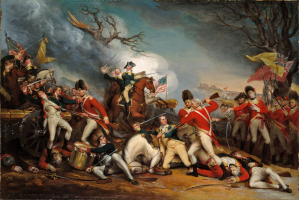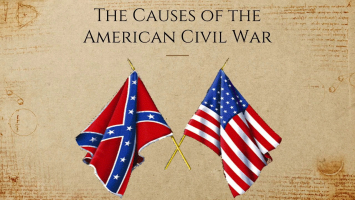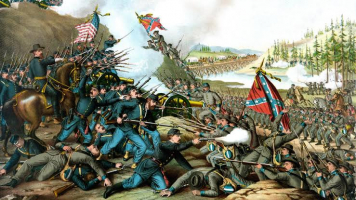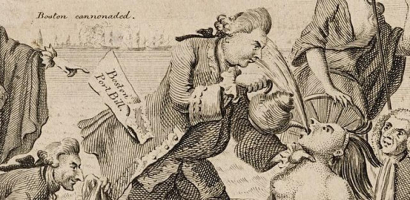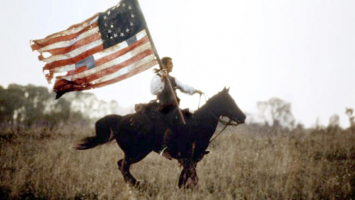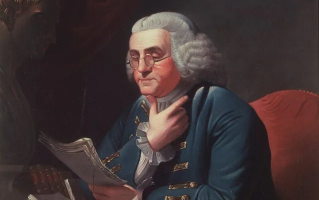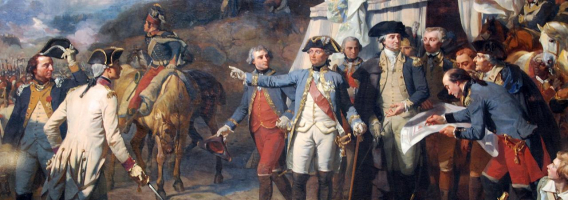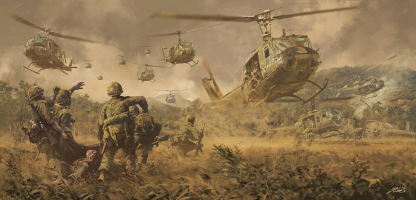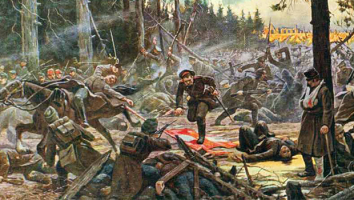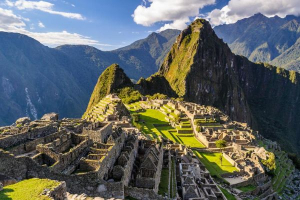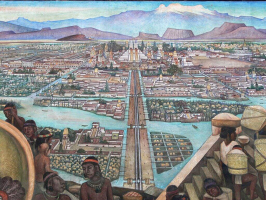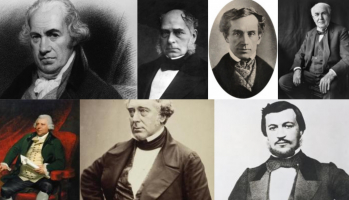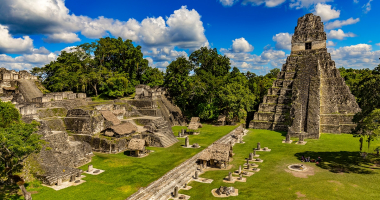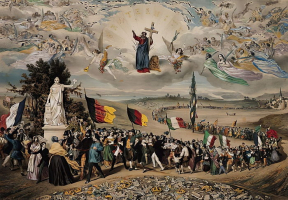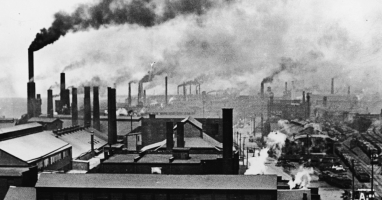Top 10 Major Battles of the American Civil War
A four-year violent conflict between the Union and the separatist Confederate States of America began when Southern rebels bombarded Fort Sumter in South ... read more...Carolina in April 1861. The names of a few revered sites, including Gettysburg and Shiloh, come to mind when we think of the Civil War today. However, the scale of the conflict was much greater and bloodier. More than 10,000 armed skirmishes between Union and Confederate forces took place across the country, from minor altercations to major battles involving tens of thousands of men, in places like Vermont and Arizona. There are major battles of the American Civil War you can read below!
-
One of the major battles of the American Civil War is the First Bull Run battle. Irvin McDowell of the Union led a march from Washington, D.C. into Virginia to capture Richmond, the Confederate capital, and put an end to the war. However, the majority of McDowell's troops were novice 90-day volunteers who had signed up in the hope of engaging in a quick battle and had no idea what was ahead of them. They encountered an army under the command of Gen. Pierre G. T. Beauregard, which was guarding a crucial railroad intersection in Virginia at Manassas. The Confederates were first beaten back from the offensive by McDowell's soldiers, but reinforcements soon came, including a brigade led by then-Brig. Gen. Thomas J. Jackson gained the moniker "Stonewall" for his determination to hold the line.
A total of 2,896 people are believed to have died, were injured, went missing, or were captured during the war's opening significant engagement. 1,982 of the Confederates who won the battle also perished. It became clear as each side recorded their casualties that the conflict would last longer and be bloodier than what Americans had anticipated.
Time: July 21, 1861
Place: Virginia
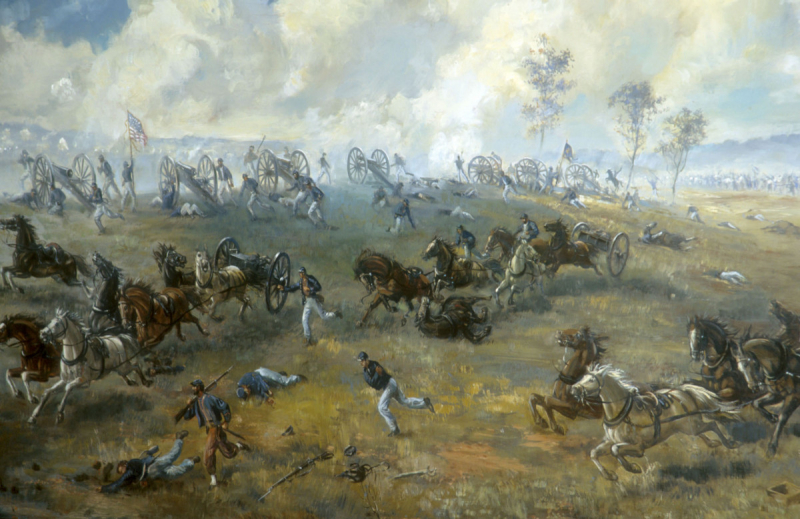
Photo: https://www.history.com/ 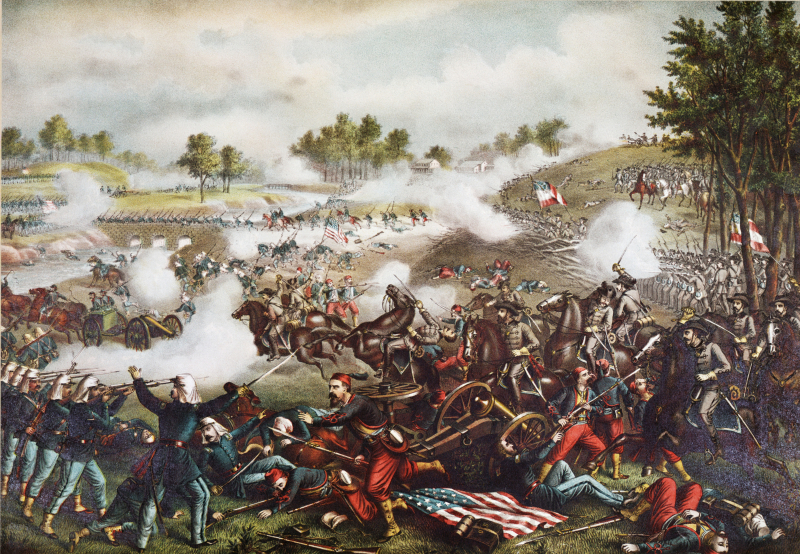
Photo: https://en.wikipedia.org/ -
Control of the main rivers would be essential for victory in the Western Theater, Union leaders knew early in the conflict. Gen Ulysses S. Grant’s moved 12 miles across the country to take Fort Donelson on the Cumberland River on February 6, 1862, after taking Fort Henry on the Tennessee River. By the 13th of February, Grant had surrounded the fort with roughly 25,000 troops and launched several minor raids to test its defenses. Confederate commander Brig. Gen. John B. Floyd oversaw a garrison of three divisions totaling over 16,000 troops and cavalry inside and outside the fort. On February 14, Union Navy gunboats attempted to weaken the fort but were repulsed by more powerful Confederate guns. The Confederates launched a surprise assault on Grant's lines' right flank the following morning. Despite some success, Grant launched a counterattack in the late afternoon, and Floyd gave the order for his soldiers to retreat within the fort.
Floyd and a few other top officers left the fort on February 16, handing over control to Grant's old ally Gen. Simon Bolivar Buckner. Later that day, Buckner grudgingly gave his old friend unconditional control of the remaining garrison. Major triumphs for Grant included the conquest of Forts Henry and Donelson. They allowed Union forces to proceed along the Tennessee and Cumberland Rivers in Tennessee. As a result of his triumph, Grant was promoted to major general and rose to prominence in the Western Theater, receiving the nickname "Unconditional Surrender."
Time: February 11, 1862 – February 16, 1862
Place: Tennessee River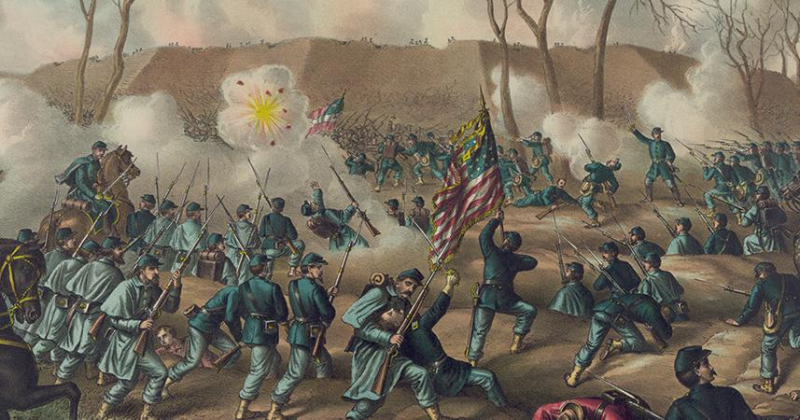
Photo: https://www.battlefields.org/ 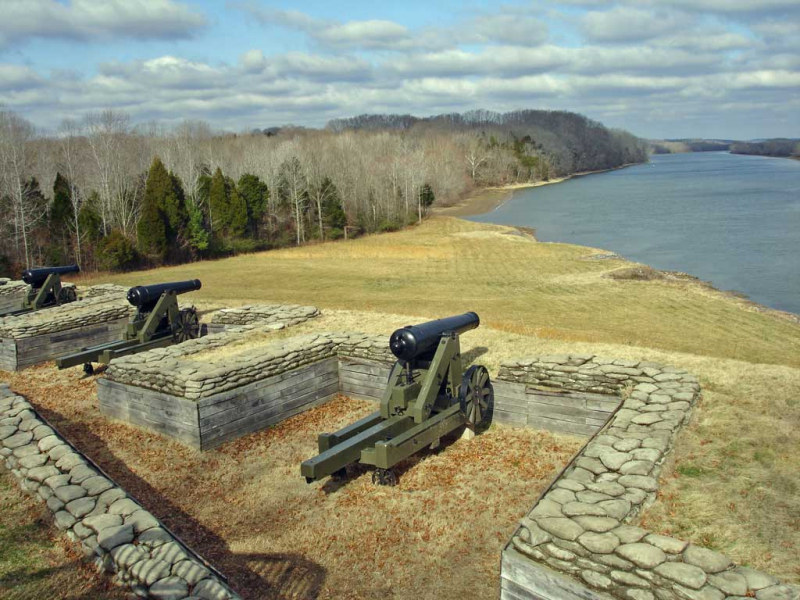
Photo: https://en.wikipedia.org/ -
Antietam battle is considered one of the major battles of the American Civil War. To put the Union on the defensive, General Robert E. Lee and his Army of Northern Virginia invaded Maryland. To stop him, President Abraham Lincoln dispatched Major General George McClellan and his Army of the Potomac.
The initial encounter between the two groups took place at dawn in a cornfield in Sharpsburg, Maryland, where the tall corn stalks hid their movements as they exchanged fire. The action later moved to a stone bridge over Antietam Creek, where Union soldiers had to make three unsuccessful attempts to take a Confederate position before they succeeded. On both sides, 22,717 men are thought to have perished, been injured, taken prisoner, or gone missing.
Lee's assault was thwarted by the Union, even though the combat ended in a draw. That gave Lincoln the self-assurance he needed to proclaim emancipation, which changed the focus of the Civil War from one fought to maintain the Union to one fought to abolish slavery. Northerners were also made aware of the gruesome cost of the war by images taken by Alexander Gardner of bodies scattered over the battlefield and displayed in Matthew Brady's museum in New York.
Time: September 16, 1862 – September 18, 1862
Place: Maryland
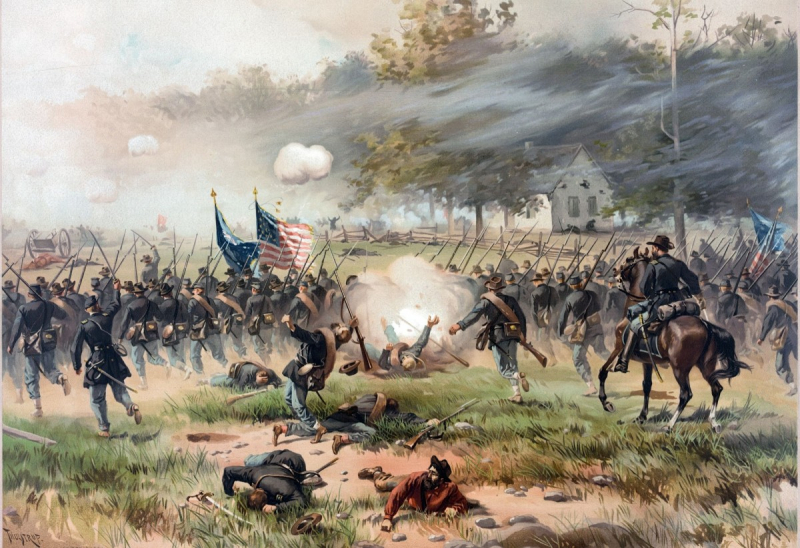
Photo: https://www.history.com/ 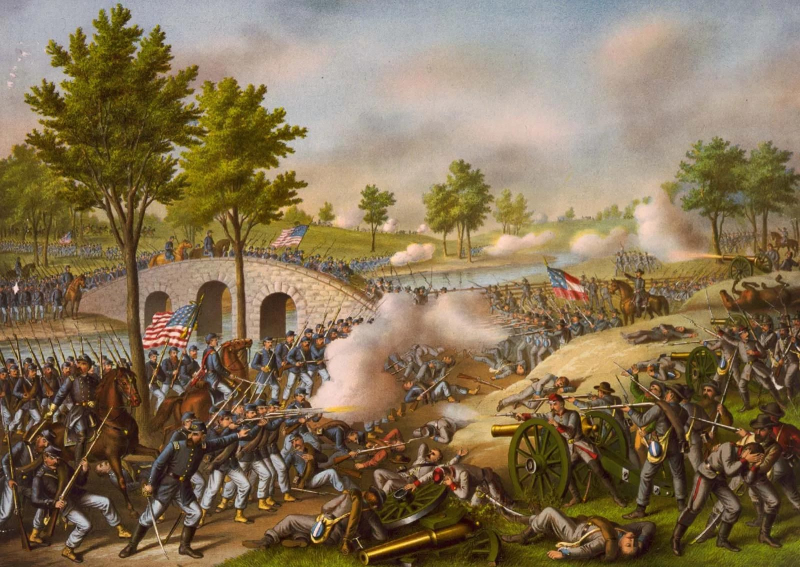
Photo: https://www.britannica.com/ -
Maj. Gen. Joseph Hooker began a turning operation on April 27, 1863, to force Robert E. Lee's Army of Northern Virginia out of its positions at Fredericksburg. The operation was effective, and by April 30 portions of Hooker's Army of the Potomac had arrived nine miles to Lee's rear at the Chancellorsville crossroads. Hooker, who outnumbered Lee two to one, was prepared to kill the Confederates. Lee marched west after learning of Hooker's march and leaving a supporting army behind at Fredericksburg.
On May 1, fighting broke out, and the Federals eventually returned to Chancellorsville. With the upper hand, Lee would now divide his force once more and dispatch Lt. Gen. Thomas J. "Stonewall" Jackson on a march to attack Hooker's right flank. Jackson was wounded by friendly fire and died eight days later when his soldiers attacked Maj. Gen. Oliver O. Howard's XI Corps, which had breached the Union line the previous evening. On May 3, Lee redoubled his assault and drove Hooker from Chancellorsville. At the height of his success, Major General John Sedgwick's VI Corps, which had made a breakthrough at Fredericksburg, compelled Lee to divide his army a third time. At Salem Church, the Confederates stopped Sedgwick's advance. On the evening of May 5, Hooker decided to withdraw and end his campaign after being stalled on two fronts. The conflict, which is regarded as Lee's biggest triumph, motivated him to mount a second invasion of the North.
Time: April 30, 1863 – May 6, 1863
Place: Virginia
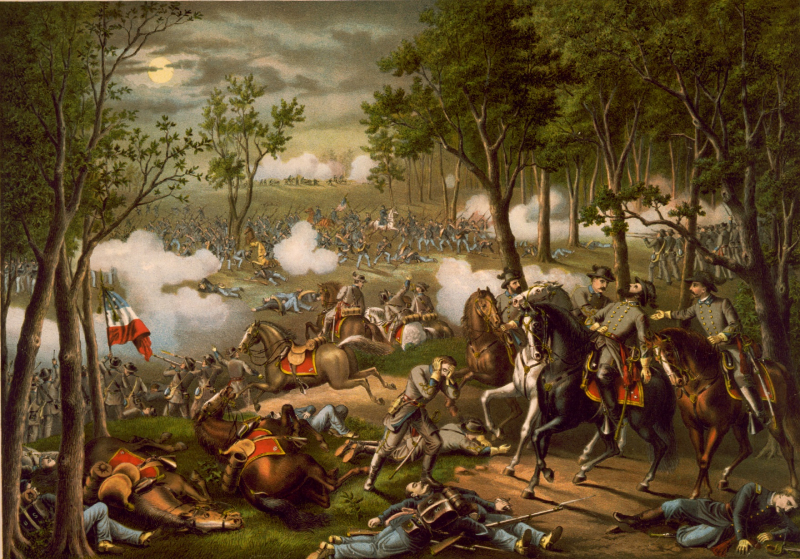
Photo: https://vi.wikipedia.org/ 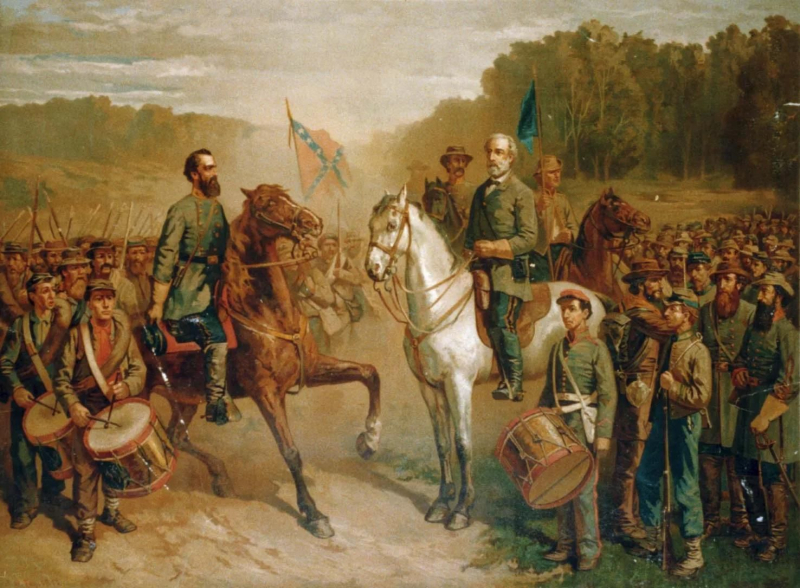
Photo: https://www.britannica.com/ -
Vicksburg, Mississippi, a fortified port and railroad center on the Mississippi River, was viewed by Confederate President Jefferson Davis as "the nailhead that holds the two parts of the South together." It became necessary for the Union to capture what was referred to as the Gibraltar of the Confederacy as a result.
Grant sent his troops to attack the city multiple times in the middle of May, but they were unable to get past the Confederates' walls. As a result, he was obliged to begin a protracted siege during which he blasted Vicksburg with artillery and fire from Union gunboats, and starved Confederate defenders, and the civilian populace. Many hid in the city's underground man-made caverns.
Grant made one more attempt at an assault in June, sending miners under the Confederate defenses to set explosives and dig a 12-foot-deep crater. However, the Union forces were forced to retreat after being unable to advance out of it. By July, Grant was forced to accept the surrender of Confederate Lt. Gen. John C. Pemberton and his 29,000 soldiers.
With the win, the Union gained control over the entire Mississippi River's vital supply route. The Confederacy was also divided.
Time: May 18, 1863 – July 4, 1863
Place: Mississippi
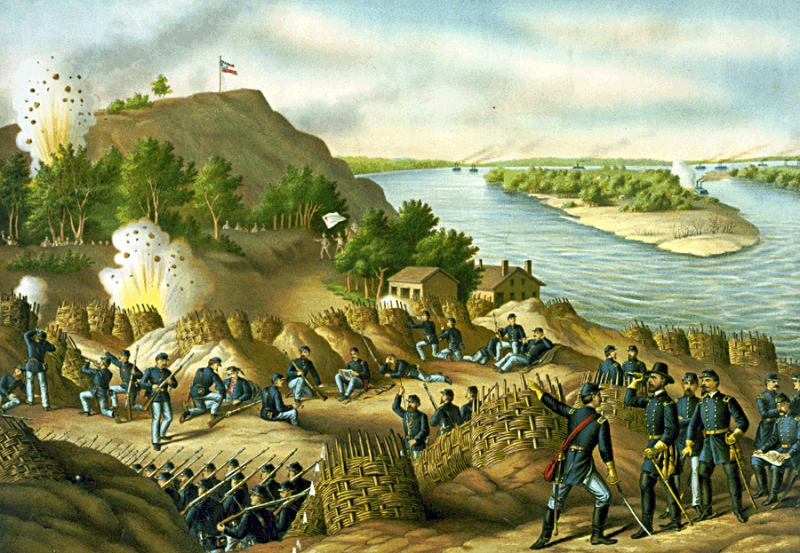
Photo: https://vi.wikipedia.org/ 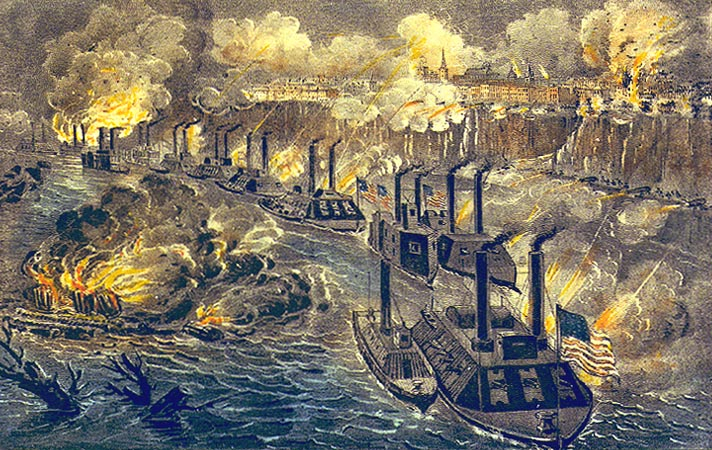
Photo: https://en.wikipedia.org/ -
To defeat the Union on its turf, intimidate Washington, D.C., and pressure Lincoln into signing a peace settlement, Lee once more invaded the Union in the summer of 1863.
Additionally, he needed supplies for his soldiers severely because the battle had devastated Virginia. Lee's Army of Northern Virginia was pursued by Union forces under the command of Maj. Gen. George Meade, who eventually caught up with them in Pennsylvania and engaged the Confederates in one of history's most crucial battles at Gettysburg.
The Confederates first drove Union forces from fields to the west and north of the town, but on the second day, they were unable to breach the Union defenses. On July 3, at Cemetery Ridge, south of Gettysburg, Lee launched an assault on the Union forces' nerve center. Confederate Gen. George Pickett led two brigades in an assault on the Union position after two hours of the firing. Pickett's Charge, as it came to be called, was a catastrophe, with 60 percent of the deaths falling on the Confederates. Lee was compelled to turn around and stop his invasion.
The Confederacy suffered a severe defeat in the combat, and both sides suffered terrible losses. 23,000 Union soldiers died, compared to 28,000 Confederate soldiers. The South's ambitions for the Confederacy's international recognition were dashed. Lee was discouraged when President Jefferson Davis rejected his resignation request.
When President Lincoln visited the battleground and gave the Gettysburg Address in November 1863, the significance of the battle increased. Lincoln recast the war as a struggle for the nation in his infamously succinct but impactful speech, which also acknowledged the sacrifice of the troops who lost their lives there.
Time: July 1, 1863 – July 3, 1863
Place: Pennsylvania
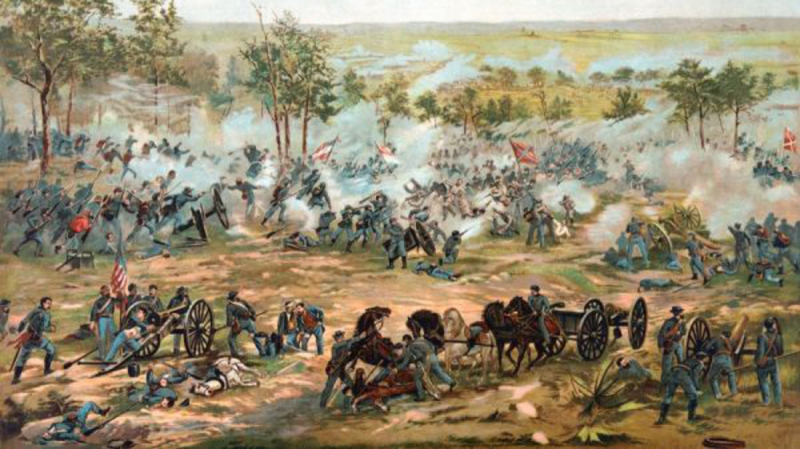
Photo: https://www.history.com/ 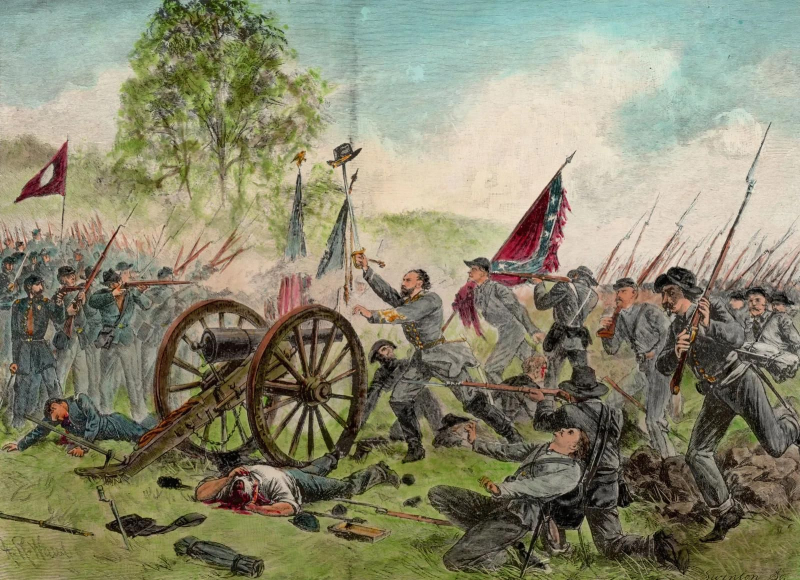
Photo: https://www.britannica.com/ -
A desperate Confederate onslaught outside of Atlanta, which was met by a trio of Union troops under the command of Gen. William T. Sherman near the end of the war, failed.
The Union suffered 3,700 losses during the Battle of Atlanta, while the Confederates suffered 5,500 casualties, making it the worst day in Sherman's March through Georgia. After advancing further and eventually encircling the city, Sherman's men besieged it for the entire month of August.
After fighting at Antietam and Gettysburg and losing a leg at the Battle of Chickamauga, Confederate Lt. Gen. John Bell Hood finally surrendered and left the city on September 1, allowing Sherman's men to enter.
The Confederate war effort was weakened by Atlanta's capture. When Lincoln faced a tough election in 1864 against George B. McClellan, one of his former generals, the victory gave him a boost in the polls, enabling him to win and continue the war to its conclusion.
Time: July 22, 1864
Place: Georgia
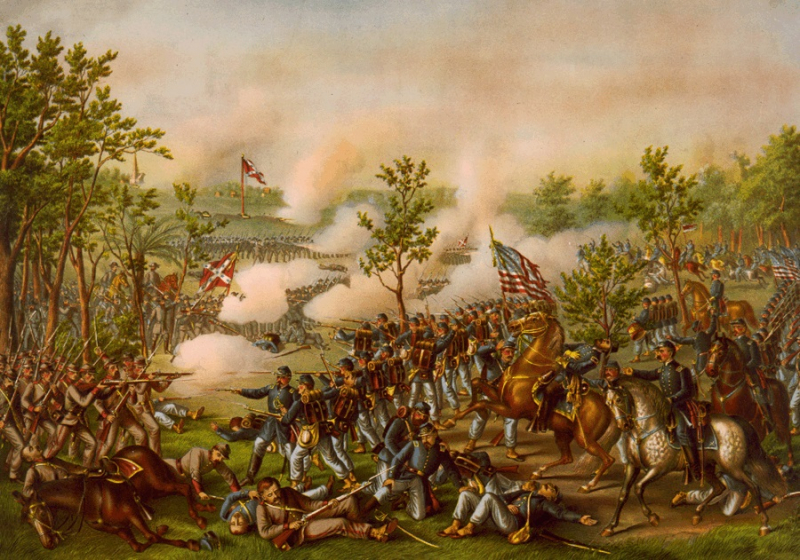
Photo: https://en.wikipedia.org/ 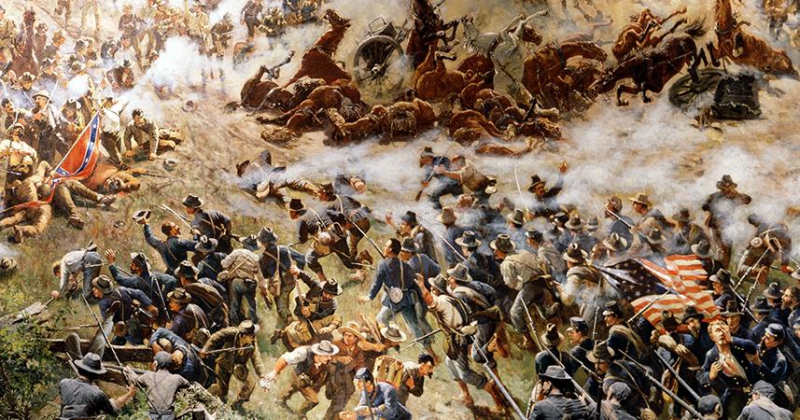
Photo: https://www.battlefields.org/ -
Gen. Albert Sidney Johnston led 40,000 Confederate forces in an attack on the Union divisions camped close to Pittsburg Landing on the Tennessee River early on April 6, 1862. Major General Ulysses S. Grant's entire Army of Tennessee was in danger of being overrun by the overwhelming Confederate offensive, which also forced the unprepared Federal men back. A fighting line had been constructed at the "Hornet's Nest" by the afternoon after some Federal units took firm positions. Numerous defending Yankees were killed or seriously injured as a result of Rebel attacks that were repeatedly supported by a large amount of artillery. After General Johnston suffered a fatal injury, Gen. Pierre G.T. Beauregard took over.
The Union army held up despite fighting that lasted until after nightfall. The Army of Ohio under Maj. Gen. Don Carlos Buell had joined Grant the previous night, and Grant outnumbered Beauregard by the following morning. Along the entire line, Grant launched a counteroffensive that overpowered the depleted Confederate forces and drove Beauregard's army from the battlefield. Any aspirations the Confederacy had of stopping the Union's push into northern Mississippi were dashed by their setback. The bloodiest fight in American history up until that point, the two-day combat of Shiloh cost more than 23,000 lives. It is also one of the major battles of the American Civil War.
Time: April 6, 1862 – April 7, 1862
Place: Tennessee
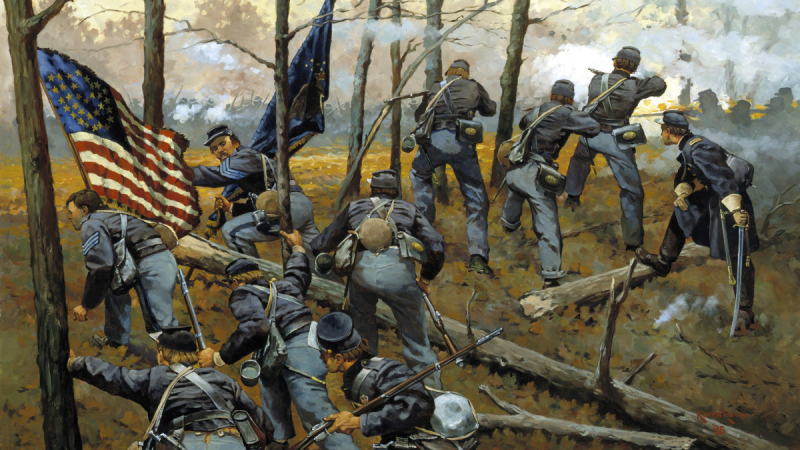
Photo: https://www.history.com/ 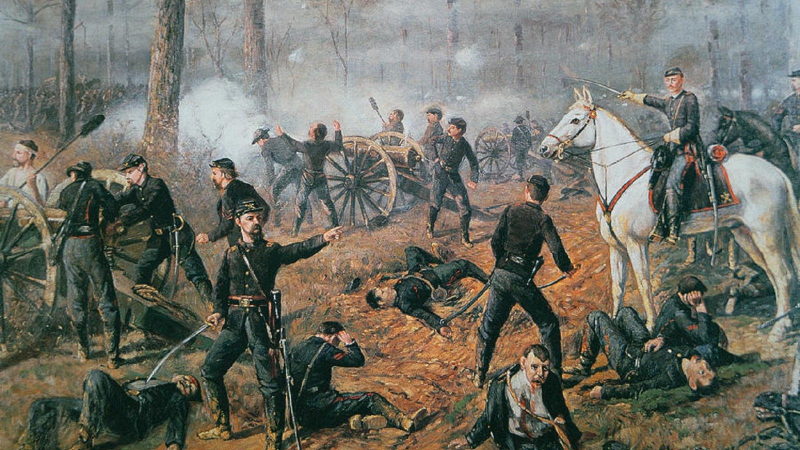
Photo: https://www.nps.gov/ -
Early in September 1863, the Union troops had taken control of the important railroad hub of neighboring Chattanooga, Tennessee. Braxton Bragg, the commander of the Confederate forces, met William Rosecrans' Union army at Chickamauga Creek to reclaim control. The majority of the combat took place on September 19, 1863.
Maj. Gen. William Rosecrans carried up the Union offensive after the victorious Tullahoma Campaign to drive Gen. Braxton Bragg's Confederate army from Chattanooga. Bragg was ejected from Chattanooga and pressed into Georgia by Rosecrans with a series of deft marches in the direction of the city controlled by the Confederates. Bragg, who was determined to retake the city, pursued the Federals to the north, coming into contact with Rosecrans' force at Davis' Cross Roads. On September 18, his cavalry and infantry engaged Union mounted men who were armed with cutting-edge Spencer repeating rifles as they marched. On the morning of the 19th, the fighting got going close to Chickamauga Creek. Rosecrans' line was vigorously attacked by Bragg's forces, but the Union line withstood.
The next day, fighting started up again. Eight new brigades from the Army of Northern Virginia, led by Lieut. Gen. James Longstreet took advantage of a weakness in the Federal defense that afternoon and expelled one-third of the Rosecrans army, including Rosecrans himself. By defending Horseshoe Ridge against numerous assaults, just a small section of the Federal force, led by Maj. Gen. George H. Thomas prevented disaster and allowed the Yankees to retreat after dusk. Thomas gained the moniker "the Rock of Chickamauga" as a result of this deed. The defeated Union forces fled to Chattanooga, where they stayed up to the end of November. One of the fiercest engagements in the Western Theater is known as Chickamauga.
Time: September 18, 1863 – September 20, 1863
Place: Georgia
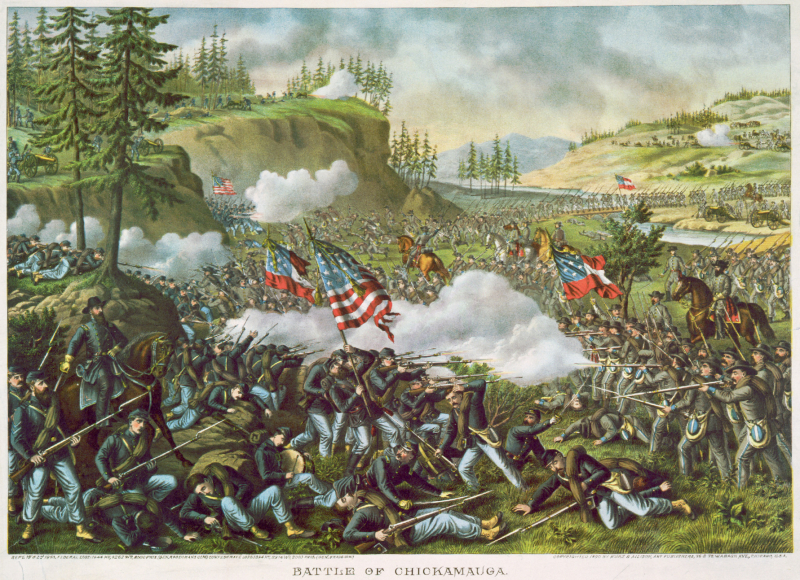
Photo: https://www.historynet.com/ 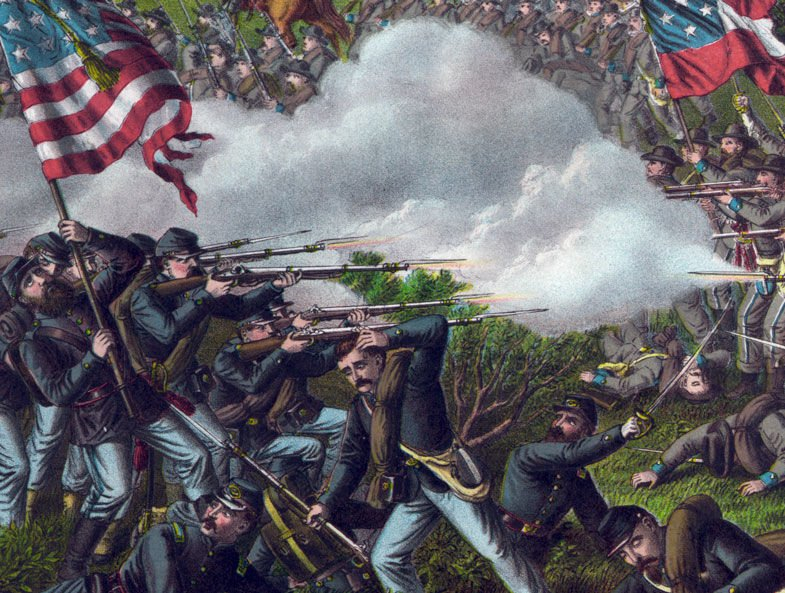
Photo: https://www.northwestgeorgianews.com/ -
General Robert E. Lee moved west down the Appomattox River after being relentlessly harassed by Federal troops and being prevented from heading south to assist Gen. Joseph Johnston's army in North Carolina. He eventually arrived in Appomattox County on April 8th. His target was the Appomattox Station station on the South Side Railroad, where food supplies were waiting. First to arrive at the station, the Union cavalry led by Brig. Gen. George A. Custer seized three supply trains. Confederate artillery under Brig. Gen. Reuben L. Walker and a few cavalry troopers camping nearby attacked Custer's men while they were at the station. The surprise encounter with Custer's forces, a lack of organization, and the absence of a central leadership made the Confederates' situation difficult. The unusual battle paired mounted cavalry against artillery that had no infantry assistance.
Confederate artillery crews served as infantry skirmishers for the majority of the conflict. Despite the challenging terrain and dense cover, Custer's soldiers assaulted the Confederate artillery, captured 25 guns, and dispersed the defenders. Lee's expectation of locating food and supplies in the area was dashed by the events at Appomattox Station, which probably had an impact on his choice to meet Grant the next day at nearby Appomattox Court House.
Time: April 8, 1865
Place: Virginia
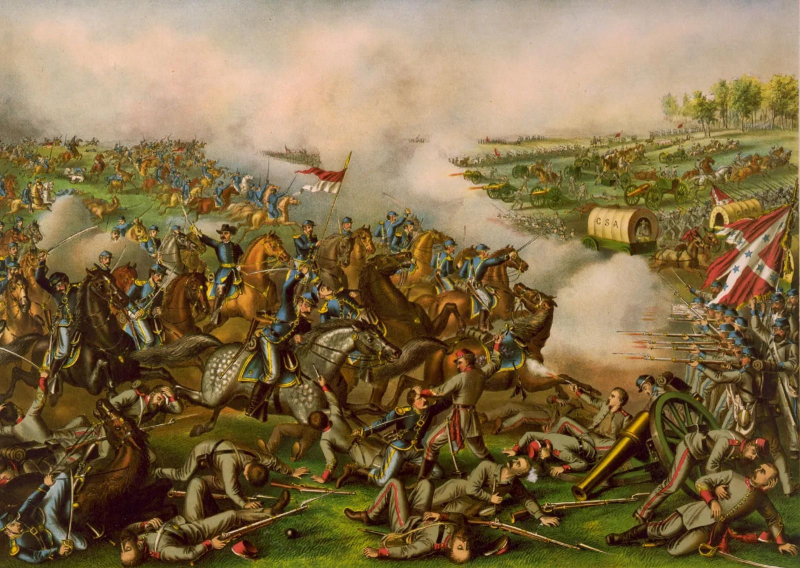
Photo: https://www.britannica.com/ 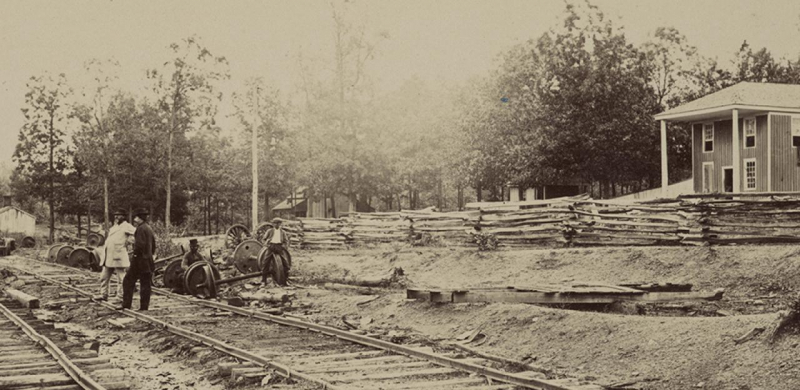
Photo: https://www.battlefields.org/












